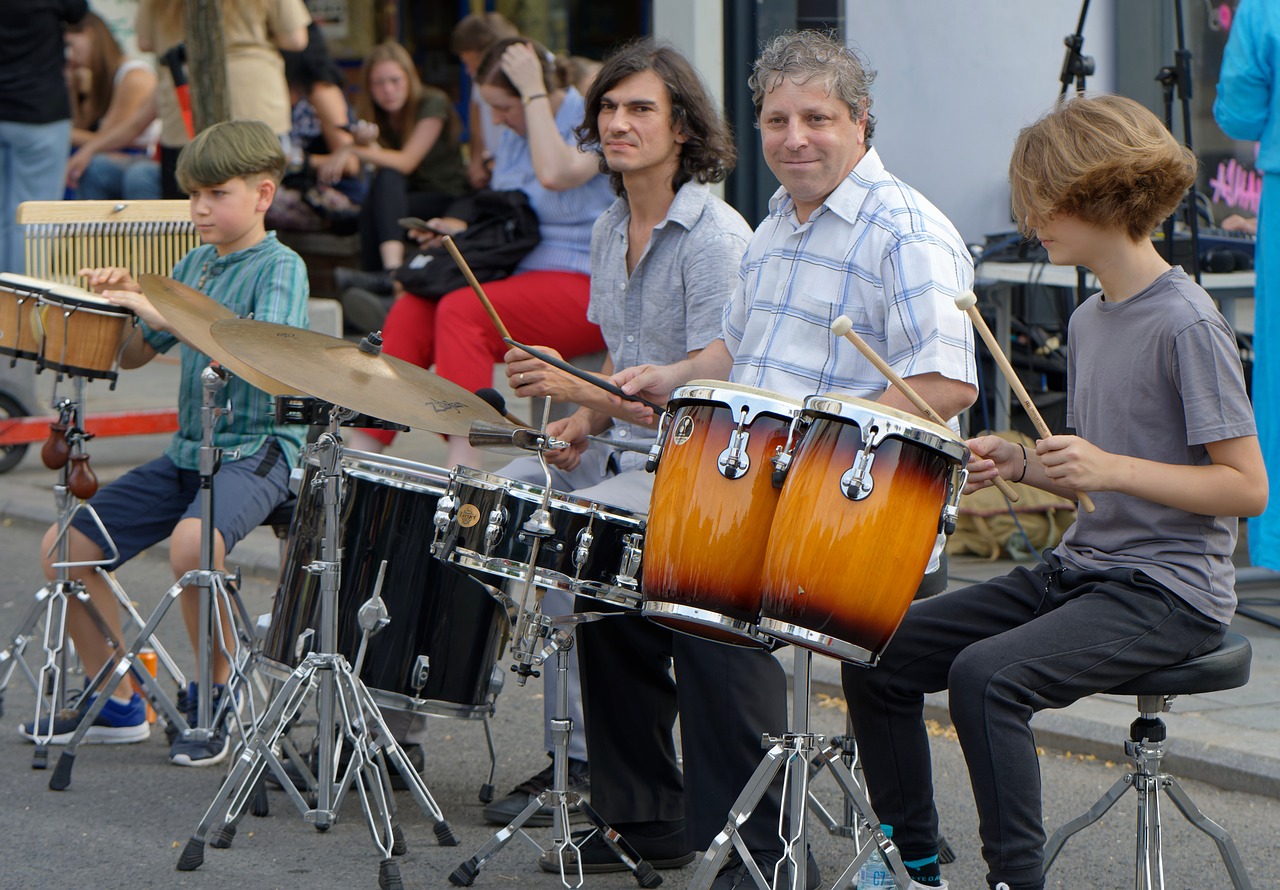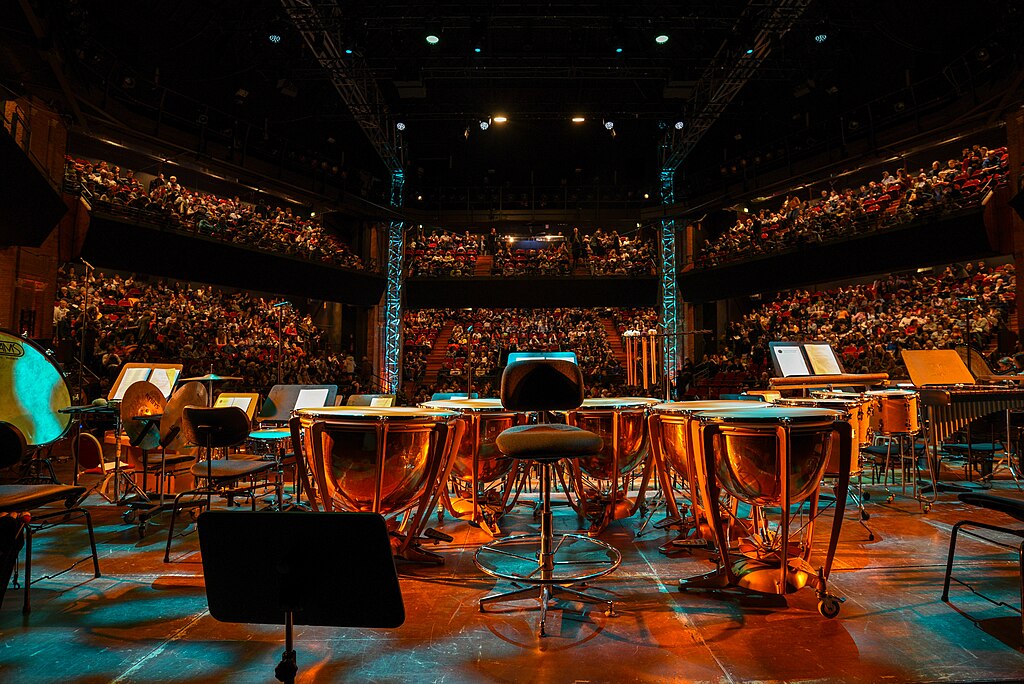The sound of a timpani roll crescendos, filling the concert hall with anticipation. A young student, sitting in the audience, is mesmerized by the power and precision of the orchestral percussion section. This experience ignites a spark within the student, a desire to explore the world of percussion and unlock its potential. Learning orchestral percussion offers numerous educational benefits for students, extending far beyond musical skills alone.
Orchestral percussion education is a transformative journey that enriches students’ lives in countless ways. By diving into the world of percussion instruments, students embark on a path of rhythmic discovery, developing essential skills such as timing, coordination, and teamwork. The impact of percussion education reaches beyond the concert hall, influencing cognitive development, emotional growth, and academic performance.
In this article, we will explore the multifaceted benefits of learning orchestral percussion and how it can be integrated into music education curricula. We will delve into the various skills students acquire through percussion training, including rhythm development, hand-eye coordination, and collaborative abilities. Additionally, we will examine the cognitive and emotional advantages of percussion education, backed by scientific research and expert insights.
As we unravel the educational value of orchestral percussion, we will also provide practical tips and resources for educators, parents, and students alike. From incorporating engaging percussion activities in the classroom to fostering a lifelong love for music, this article aims to empower readers to embrace the transformative power of percussion education.
Whether you are a music teacher seeking to expand your curriculum, a parent looking to enrich your child’s development, or a student curious about the world of orchestral percussion, this article will provide valuable insights and inspiration. Join us on this educational journey as we explore the profound impact of orchestral percussion, from the concert hall to the classroom.
Understanding Orchestral Percussion
Orchestral percussion is a crucial component of any symphony orchestra, providing a wide range of tonal colors, rhythmic elements, and dynamic contrasts. To grasp the educational value of percussion, it is essential first to understand what orchestral percussion entails.
At its core, orchestral percussion refers to the family of instruments that are struck, shaken, or scraped to produce sound. These instruments are divided into two main categories: pitched percussion and unpitched percussion. Pitched percussion instruments, such as the timpani, xylophone, and chimes, produce distinct musical notes, while unpitched percussion instruments, like the snare drum, bass drum, and cymbals, create rhythmic and textural effects.

Image Source (Pixabay)
The common orchestral percussion instruments include:
1. Timpani: Large, kettle-shaped drums tuned to specific pitches (learn more in my Ultimate Timpani Guide)
2. Snare drum: A shallow drum with a distinctive rattling sound produced by wires stretched across the bottom head
3. Bass drum: A large, deep-sounding drum that provides a strong rhythmic foundation
4. Cymbals: Round, metal plates that produce a crashing or sustained sound when struck together or with a drumstick
5. Triangle: A small, metal instrument that creates a high-pitched, ringing sound
6. Tambourine: A handheld frame drum with metal jingles around the edges
7. Xylophone: A pitched percussion instrument with wooden bars arranged like a piano keyboard
8. Glockenspiel: Similar to a xylophone but with metal bars, producing a brighter, more penetrating sound
9. Chimes: A set of vertical metal tubes that produce a clear, bell-like tone
10. Marimba: A large, pitched percussion instrument with wooden bars and resonators beneath each bar
Find out more in my blog post:- Orchestral Percussion & Instruments | The Orchestras Beating Heart
In an orchestra, the percussion section plays a vital role in adding depth, texture, and rhythmic drive to the ensemble. Percussion instruments can emphasize important musical moments, create special effects, and provide a backbone for the rhythmic structure of a piece. From the thundering timpani rolls in Beethoven’s symphonies to the shimmering glockenspiel passages in Tchaikovsky’s ballets, orchestral percussion adds a dimension of excitement and drama to the music.
Understanding the diverse range of orchestral percussion instruments and their roles within an ensemble is essential for students, educators, and music enthusiasts alike. By familiarizing themselves with these instruments and their unique characteristics, individuals can better appreciate the complexity and artistry involved in orchestral percussion performance and education.
In the following sections, we will explore how learning orchestral percussion can benefit students in various aspects of their development, from rhythm and coordination to cognitive skills and emotional growth. We will also discuss strategies for incorporating percussion education into school curricula and provide resources for further exploration.
Rhythm and Timing Skills
One of the most fundamental benefits of learning orchestral percussion is the development of rhythm and timing skills. Rhythm, the pattern of regular or irregular pulses in music, is the foundation upon which all musical elements are built. Percussion instruments, with their inherent rhythmic nature, provide an ideal platform for students to explore and master rhythmic concepts.
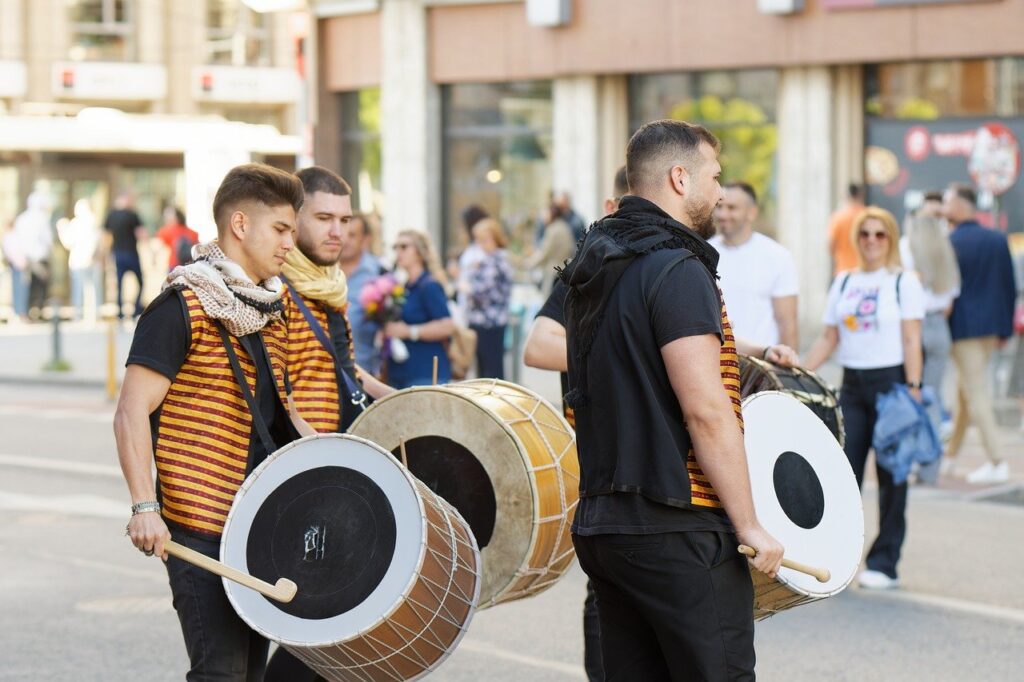
Image Source (Pixabay)
When students begin learning percussion instruments, they are introduced to basic rhythmic patterns, such as crotchets, quavers, and minims. As they progress, they encounter more complex rhythms, including syncopation, polyrhythms, and odd time signatures. Through regular practice and exposure to diverse musical styles, students develop a strong sense of pulse, meter, and rhythmic accuracy.
Developing solid timing skills is crucial not only for musical performance but also for various aspects of life. Accurate timing and the ability to maintain a steady beat are essential for activities such as dancing, sports, and public speaking. By internalizing rhythmic structures, students learn to anticipate, react, and synchronize their movements with precision.
To cultivate rhythm and timing skills, percussion educators employ various exercises and activities, such as:
1. Clapping or tapping rhythmic patterns
2. Playing along with a metronome or drum tracks
3. Engaging in call-and-response rhythmic games
4. Performing rhythm rounds or canons
5. Improvising rhythmic solos within a given structure
In addition to these exercises, students can also benefit from exploring different musical genres and styles. Each style, whether it be classical, jazz, rock, or world music, has its own rhythmic characteristics and grooves. By exposing students to a wide range of musical contexts, educators can help them develop versatility and adaptability in their rhythmic skills.
As an experienced percussionist and educator, I have witnessed firsthand the transformative power of rhythmic training. One of my students, who struggled with reading and maths, found that learning percussion improved their ability to recognize patterns and maintain focus. Through consistent practice and dedication, this student not only excelled in their musical pursuits but also transferred their newfound skills to their academic studies, leading to improved grades and confidence.
The benefits of developing rhythm and timing skills through orchestral percussion extend far beyond the realm of music. By mastering these skills, students lay the foundation for a lifetime of musical enjoyment, cognitive development, and personal growth. In the next section, we will explore how learning percussion can enhance coordination and motor skills, further contributing to a student’s overall development.
Coordination and Motor Skills
Playing orchestral percussion instruments requires a high level of coordination and motor control. From the precise arm movements needed to strike a timpani to the delicate finger work required for playing a triangle, percussion students must develop a keen sense of body awareness and control.
Coordination, the ability to use different parts of the body together smoothly and efficiently, is a fundamental skill that percussion education helps to refine. When playing percussion instruments, students must often simultaneously use both hands, and sometimes even their feet, to produce the desired sounds. This process of coordinating multiple limbs encourages the development of bilateral coordination, which is essential for many daily activities, such as typing, driving, and sports.
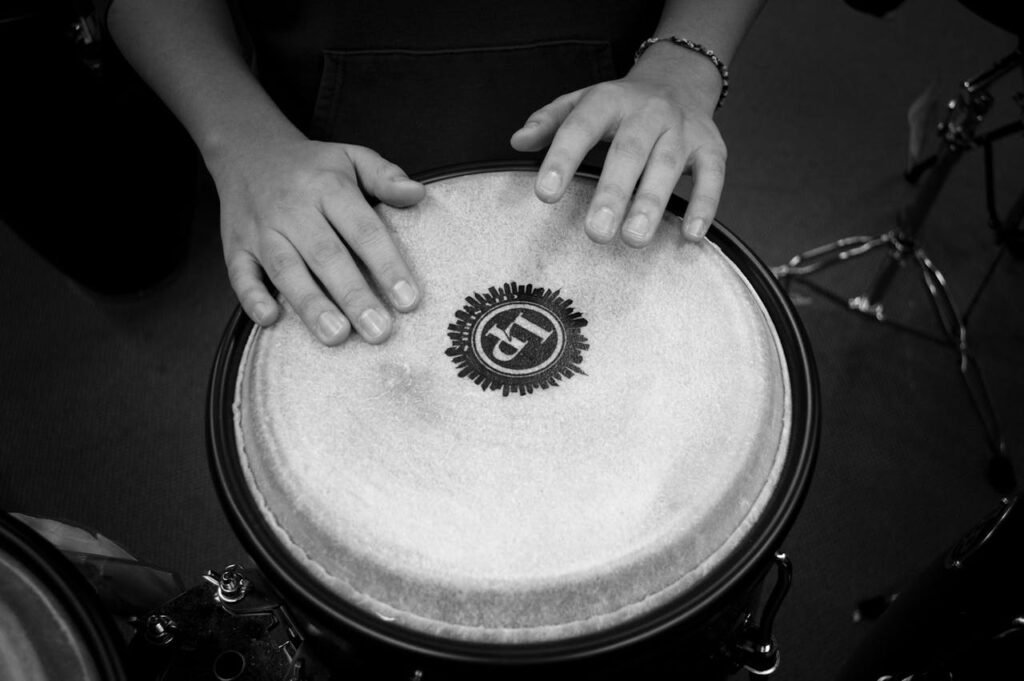
Image Source (Pexels)
Moreover, learning percussion enhances both fine and gross motor skills. Fine motor skills involve the use of small muscles in the hands and fingers, such as those required for gripping a drumstick or controlling the rebound of a mallet. Gross motor skills, on the other hand, involve larger muscle groups and whole-body movements, such as maintaining proper posture while sitting at a drum set or moving between different percussion instruments in an orchestral setup.
Regular practice on percussion instruments helps students develop dexterity, speed, and accuracy in their movements. As they progress in their skills, they learn to execute increasingly complex patterns and techniques, such as drum rudiments, mallet dampening, and cross-sticking. These skills not only contribute to their musical proficiency but also have far-reaching benefits in other areas of life, such as improved hand-eye coordination, faster reaction times, and better overall motor control.
I have worked with students who initially struggled with coordination and motor control. One such student had difficulty holding drumsticks and producing consistent sounds. Through targeted exercises and patient guidance, we worked on developing their grip, wrist control, and stroke technique. Over time, not only did their percussion skills improve, but they also reported feeling more confident in their physical abilities and noticed improvements in their handwriting and sports performance.
While developing coordination and motor skills through percussion education is rewarding, it is essential to acknowledge the unique challenges that percussionists may face. Proper technique, ergonomics, and injury prevention are crucial considerations for educators and students alike. By promoting healthy habits, such as warming up, stretching, and maintaining good posture, percussion educators can help students optimize their motor skill development while minimizing the risk of strain or injury.
In the next section, we will explore the role of teamwork and collaboration in orchestral percussion education, highlighting how these skills contribute to students’ social and emotional growth.
Teamwork and Collaboration
Orchestral percussion education is not just about individual skill development; it is also an opportunity for students to learn valuable lessons in teamwork and collaboration. Playing percussion in an ensemble setting, whether it be a school band, orchestra, or percussion group, requires students to work together towards a common goal. Creating music that is cohesive, expressive, and engaging.

Image Source (Pexels)
In an orchestral context, the percussion section is an integral part of the larger ensemble. Percussionists must learn to blend their sounds with those of other instruments, follow the conductor’s cues, and respond to the musical needs of the moment. This process of collaboration teaches students the importance of active listening, communication, and adaptability.
Active listening involves paying attention not only to one’s own playing but also to the sounds and rhythms produced by other members of the ensemble. By developing this skill, percussion students learn to adjust their dynamics, timing, and phrasing to match those of their fellow musicians. They also become more attuned to the overall balance and texture of the music, contributing to a more unified and expressive performance.
Effective communication is another essential aspect of teamwork in orchestral percussion. Percussionists must often coordinate their efforts to execute complex rhythms, trade-offs, and transitions seamlessly. This requires clear verbal and non-verbal communication, such as counting out loud, making eye contact, and using body language to signal cues. By practicing these communication skills in a musical setting, students develop a foundation for effective collaboration in other areas of life, such as group projects, team sports, and future work environments.
Collaboration in percussion education also fosters a sense of shared responsibility and accountability. When students work together to create music, they learn that their individual contributions have a direct impact on the success of the entire ensemble. This understanding encourages them to take ownership of their role, strive for excellence, and support their fellow musicians.
One of the most rewarding aspects of teaching orchestral percussion is witnessing the growth of students as they learn to collaborate effectively. I recall a particularly challenging piece that required the percussion section to execute a series of intricate rhythmic passages in perfect unison. Initially, the students struggled to synchronize their parts, leading to frustration and tension within the group. However, through patient rehearsal, open communication, and a willingness to listen to each other, they gradually learned to work as a cohesive unit. The sense of pride and accomplishment they felt after successfully performing the piece was a testament to the power of teamwork and collaboration.
Collaborative experiences in percussion education can also have lasting impacts on students’ social and emotional development. By working together towards a shared goal, students form strong bonds with their peers, developing friendships that extend beyond the rehearsal room. They learn to support and encourage each other, celebrate successes, and overcome challenges as a team. These positive social interactions contribute to a sense of belonging, self-esteem, and emotional well-being.
In the next section, we will delve into the cognitive benefits of learning orchestral percussion, exploring how rhythm, coordination, and musical training can enhance brain development and academic performance.
Cognitive Benefits
The cognitive benefits of learning orchestral percussion are numerous and far-reaching. Engaging in musical training, particularly in the area of percussion, has been shown to have a significant impact on brain development, cognitive function, and academic performance.
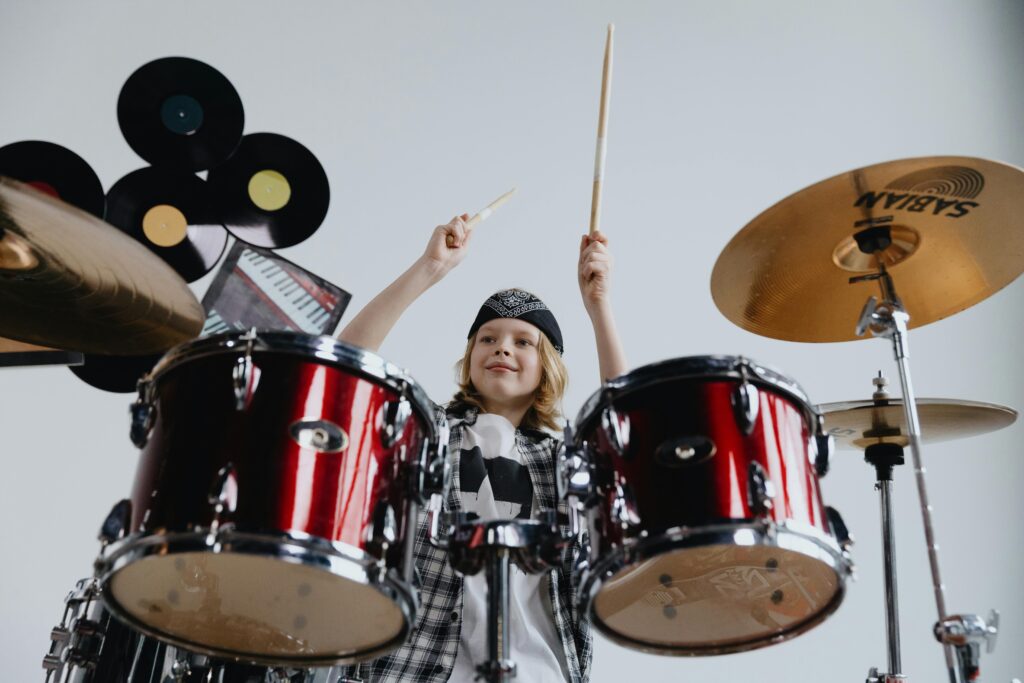
Image Source (Pexels)
At the core of percussion education lies the development of rhythm and timing skills. Research has demonstrated that the ability to process and produce rhythmic patterns is closely linked to cognitive abilities such as attention, memory, and executive function. A study published in the journal “Frontiers in Neuroscience” found that individuals with extensive musical training, including percussion, exhibited enhanced neural processing of complex temporal patterns. This suggests that learning percussion can help students develop a stronger sense of timing, which can translate to improved cognitive functioning in various domains.
Percussion education also has a positive impact on memory and concentration. Playing percussion instruments requires students to memorize complex rhythmic patterns, melodic lines, and musical structures. Through regular practice and performance, students strengthen their ability to encode, store, and retrieve information effectively. This enhancement of memory skills can benefit students in their academic pursuits, as they are better equipped to retain and recall information from various subjects.
Moreover, the process of learning percussion involves the simultaneous engagement of multiple cognitive processes, such as reading musical notation, translating that information into physical movements, and synchronizing those movements with other musicians. This multitasking aspect of percussion education can help students develop cognitive flexibility and adaptability. A study published in the journal “PLOS ONE” found that musicians who engaged in multisensory learning, such as playing an instrument while reading music, showed enhanced brain plasticity and improved learning abilities compared to non-musicians.
The cognitive benefits of percussion education extend beyond the realm of music. Research has shown that musical training can have a positive impact on academic performance, particularly in the areas of language, reading, and mathematics. A study published in the journal “Psychology of Music” found that students who received music instruction, including percussion, demonstrated improved phonological awareness, a key predictor of early reading skills. Another study, published in the journal “Educational Psychology,” revealed that students who participated in rhythmic training showed enhanced mathematical abilities, particularly in the areas of pattern recognition and problem-solving.
As an educator, I have witnessed the cognitive transformations that occur when students engage in percussion education. One particularly striking example was a student who initially struggled with reading comprehension and mathematical reasoning. As they progressed in their percussion studies, I noticed significant improvements in their ability to decode complex rhythms, memorize musical passages, and understand abstract concepts. These skills gradually transferred to their academic work, leading to improved grades and a newfound confidence in their cognitive abilities.
While the cognitive benefits of percussion education are well-documented, it is important to note that these benefits are most pronounced when musical training is consistent, long-term, and high-quality. As educators, it is our responsibility to provide students with the necessary resources, guidance, and support to ensure that they can fully reap the cognitive rewards of percussion education.
In the next section, we will explore the emotional and social benefits of learning orchestral percussion, discussing how musical engagement can foster self-expression, confidence, and interpersonal connections.
Emotional and Social Growth
Learning orchestral percussion is not only a cognitive and physical endeavor but also an emotional and social one. Engaging in percussion education provides students with unique opportunities for self-expression, personal growth, and social connection.
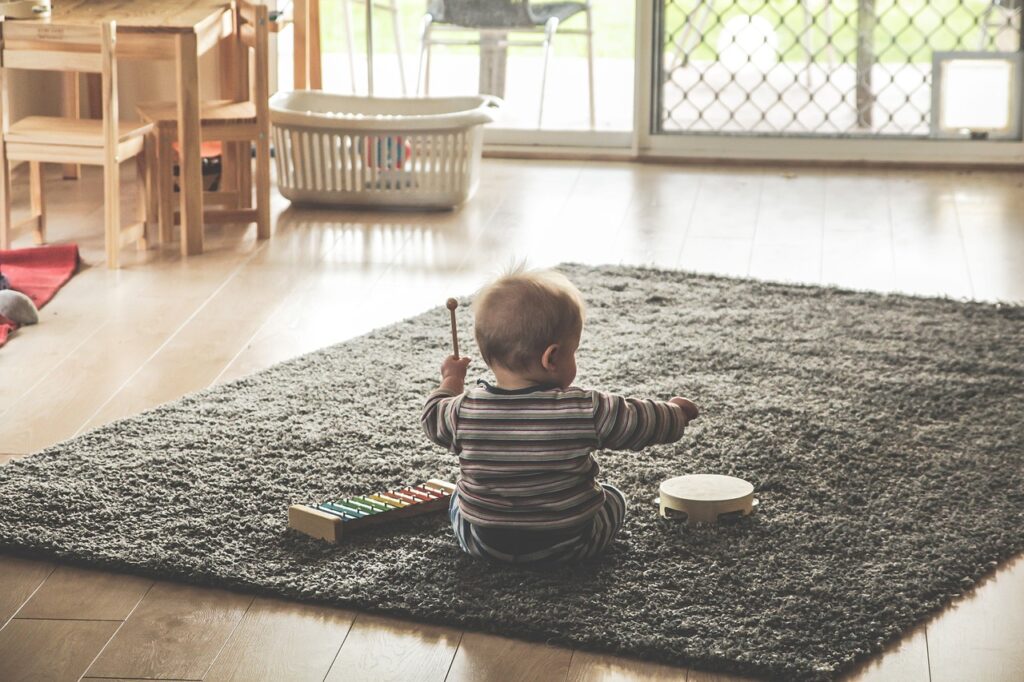
Image Source (Pixabay)
One of the most powerful aspects of percussion education is its ability to foster self-expression and creativity. Playing percussion instruments allows students to explore a wide range of emotions, from the exhilarating rush of a lively drum solo to the subtle nuances of a delicate mallet passage. By learning to convey their feelings through music, students develop a deeper understanding of their own emotions and gain a creative outlet for self-expression.
This emotional connection to music can have a profound impact on students’ mental health and well-being and studies have shown that engaging in musical activities, such as playing percussion, can reduce stress, alleviate anxiety, and promote a sense of joy and fulfillment and that music education can support students’ emotional regulation and promote positive mental health outcomes.
Moreover, the process of learning percussion can help students build self-confidence and self-esteem. As they progress in their skills and overcome musical challenges, students develop a sense of accomplishment and pride in their abilities. This boost in self-confidence can extend beyond the rehearsal room, empowering students to approach other aspects of their lives with greater assurance and resilience.
Percussion education also provides rich opportunities for social interaction and the formation of meaningful relationships. Playing in an ensemble setting, such as a school band or orchestra, allows students to connect with their peers who share a common passion for music. Through collaborative music-making, students learn to communicate effectively, support one another, and develop a sense of belonging within a community.
The social bonds formed through percussion education can have a lasting impact on students’ lives. Many of my former students have shared stories of the lifelong friendships they forged through their shared musical experiences. These connections often extend beyond the classroom, providing students with a supportive network of peers who understand and appreciate the joys and challenges of musical pursuit.
In addition to fostering peer relationships, percussion education can also provide opportunities for intergenerational connections. Many school music programs involve community performances, such as concerts or parades, where students have the chance to interact with audiences of all ages. These experiences can help students develop social skills, empathy, and a sense of connection to their broader community.
As an educator, I have witnessed the transformative power of percussion education in nurturing students’ emotional and social growth. One particularly memorable example involved a student who struggled with social anxiety and self-doubt. Through their participation in a percussion ensemble, this student gradually emerged from their shell, finding a sense of belonging and purpose within the group. As they gained confidence in their musical abilities, they also developed the courage to express themselves more freely in other social situations, forming meaningful friendships and taking on leadership roles within the school community.
While the emotional and social benefits of percussion education are significant, it is important to acknowledge that every student’s journey is unique. As educators, it is our responsibility to create a supportive and inclusive learning environment that encourages students to explore their emotions, take creative risks, and connect with others in meaningful ways.
In the next section, we will discuss strategies for incorporating orchestral percussion education into the classroom setting, providing practical tips and resources for educators and students alike.
Applying Orchestral Percussion Skills in the Classroom
Incorporating orchestral percussion education into the classroom setting can have a profound impact on students’ musical development and overall learning experience. By integrating percussion activities and concepts into the curriculum, educators can engage students in hands-on, multisensory learning that reinforces musical skills, enhances cross-disciplinary connections, and promotes a deeper understanding of music as a whole.
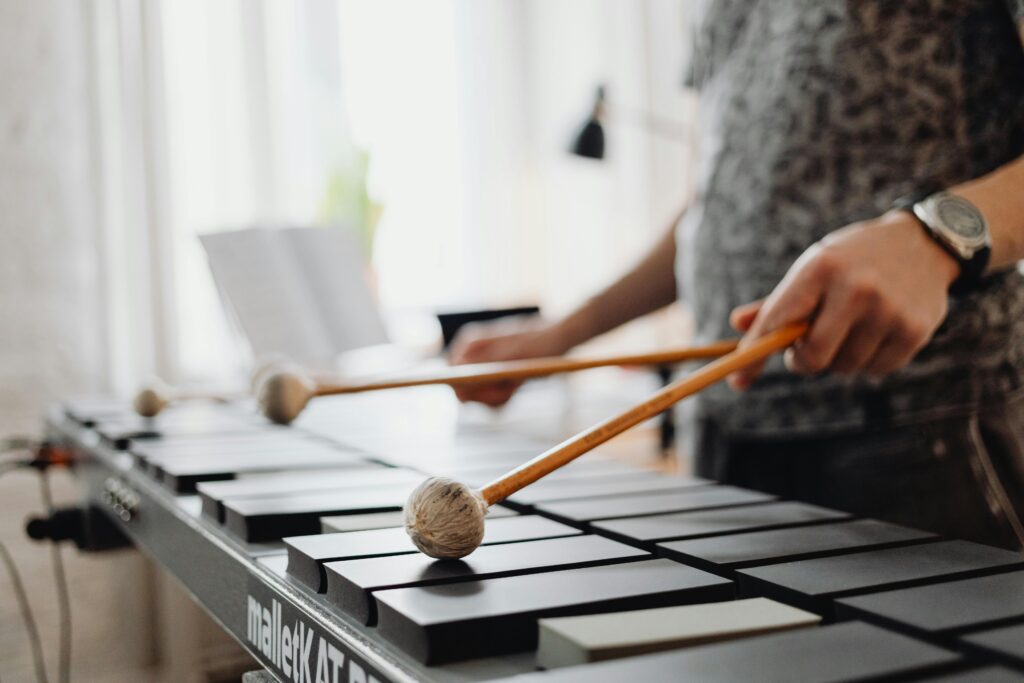
Image Source (Pexels)
One effective approach to incorporating percussion in the classroom is through the use of Orff Schulwerk, a music education philosophy that emphasizes active music-making, improvisation, and creativity. The Orff approach often involves the use of percussion instruments, such as xylophones, glockenspiels, and hand drums, to teach musical concepts and encourage student participation. By incorporating Orff-inspired activities, educators can help students develop a strong sense of rhythm, pitch, and ensemble skills while fostering a love for music-making.
Another way to integrate percussion into the classroom is through the use of bucket drumming. This accessible and low-cost approach involves using plastic buckets or other everyday objects as percussion instruments. Bucket drumming can be used to teach basic rhythmic patterns, encourage improvisation, and develop coordination skills. It is also an excellent way to engage students who may not have access to traditional percussion instruments or who may feel intimidated by more complex musical concepts.
Cross-disciplinary integration is another powerful way to incorporate percussion education into the classroom. By connecting percussion concepts to other subject areas, such as mathematics, languages, and social studies, educators can help students develop a more holistic understanding of music and its relevance to the world around them. For example, students can explore the mathematical relationships between rhythmic note values, analyze the lyrics of songs with percussion accompaniment to understand poetic devices, or study the cultural and historical significance of percussion instruments from around the world.
To effectively incorporate percussion into the classroom, educators can draw upon a wide range of resources and activities. Online platforms, such as Groove Pizza and Incredibox, offer interactive tools for creating and exploring rhythmic patterns. Music education websites, such as MusicTeachersHelper.com and NAfME (National Association for Music Education), provide lesson plans, assessment strategies, and professional development opportunities for educators seeking to integrate percussion into their teaching practice.
As a percussion educator, I have found that incorporating percussion into the classroom not only enhances students’ musical skills but also promotes a more engaging and dynamic learning environment. One particularly successful lesson involved using percussion instruments to teach the concept of fractions. By dividing the class into small groups and assigning each group a different rhythmic pattern to play, students were able to physically experience the relationships between crotchets, quavers and minims. This hands-on approach helped students grasp the mathematical concepts more readily while also developing their rhythmic accuracy and ensemble skills.
Ultimately, the key to successfully applying orchestral percussion skills in the classroom lies in the educator’s ability to create meaningful, engaging, and developmentally appropriate learning experiences. By leveraging the power of percussion education to support students’ musical, cognitive, and social-emotional growth, educators can help unlock the full potential of every learner.
In the next section, we will summarize the key benefits of orchestral percussion education and provide a call to action for educators, parents, and community members to support and advocate for percussion programs in schools.
Conclusion
Throughout this exploration of orchestral percussion education, we have highlighted many benefits that learning percussion offers to students. From the development of rhythm and timing skills to the enhancement of coordination and motor control, percussion education provides a foundation for musical excellence and personal growth.
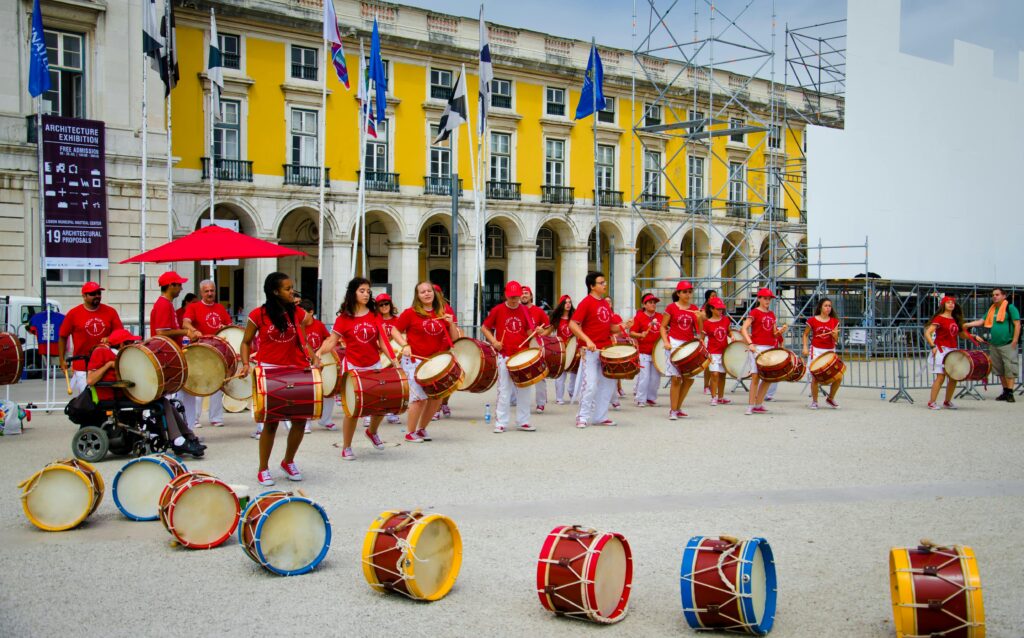
Beyond the technical skills, learning orchestral percussion also cultivates vital life skills such as teamwork, collaboration, and effective communication. Through ensemble playing and collaborative music-making, students learn to listen actively, support one another, and work towards a common goal.
These experiences not only enrich their musical journey but also prepare them for success in various aspects of their lives.
Moreover, percussion education has been shown to have significant cognitive benefits, including improved memory, concentration, and academic performance. The process of learning complex rhythms, memorizing musical passages, and engaging in multisensory experiences strengthens neural connections and promotes brain plasticity. These cognitive advantages extend beyond the realm of music, positively influencing students’ overall learning abilities and academic success.
Perhaps most importantly, orchestral percussion education provides students with a powerful outlet for self-expression, emotional growth, and social connection. Through playing percussion instruments, students can explore and express their emotions, develop self-confidence, and forge meaningful relationships with their peers. The sense of belonging and accomplishment that comes from being part of a percussion ensemble can have a lasting impact on students’ mental health and well-being.
As we have seen, the benefits of orchestral percussion education are vast and far-reaching. However, for students to fully reap these benefits, they need access to high-quality percussion programs and supportive learning environments. This is where the role of educators, parents, and community members becomes crucial.
To ensure that more students have the opportunity to experience the transformative power of percussion education, we must advocate for the inclusion of percussion programs in schools and community settings. This involves investing in resources, such as instruments and qualified instructors, and promoting the value of music education to stakeholders at all levels.
Educators play a vital role in this process by incorporating percussion into their teaching practice, creating engaging and inclusive learning experiences, and advocating for the importance of music education within their schools and districts. Parents can support their children’s percussion education by encouraging their musical interests, attending performances, and advocating for music programs in their communities.
In conclusion, orchestral percussion education is a powerful tool for fostering students’ musical, cognitive, and social-emotional development. By recognizing the value of percussion education and taking action to support and expand percussion programs, we can help unlock the potential of every student and create a more vibrant, connected, and musically enriched society.
So, let us raise our voices and our mallets in support of orchestral percussion education. Let us work together to ensure that every student has the opportunity to experience the joy, challenges, and growth that come from learning percussion. In doing so, we will not only enrich the lives of individual students but also contribute to a brighter, more harmonious future for us all.
Additional Resources
For those seeking to deepen their understanding of orchestral percussion education or explore ways to support percussion programs, there is a wealth of resources available. Below, you will find a curated list of books, websites, organizations, and educational materials that can help guide your journey.
Books
1. “Teaching Percussion” by Gary Cook – A comprehensive guide to teaching percussion instruments, covering topics such as technique, pedagogy, and curriculum development.
2. “The Percussionist’s Art: Same Bed, Different Dreams” by Steven Schick – An insightful exploration of the art of percussion performance, featuring interviews with leading percussionists and composers.
3. “The Cambridge Companion to Percussion” edited by Russell Hartenberger – A collection of essays by renowned percussionists, scholars, and educators, covering the history, repertoire, and pedagogy of percussion music.
Websites
Percussive Arts Society (PAS) – A global organization dedicated to promoting percussion education, research, and performance.
Vic Firth – A leading manufacturer of percussion sticks and mallets, offering educational resources, videos, and interviews with top percussionists.
Organizations
National Association for Music Education (NAfME) – www.nafme.org – A professional organization for music educators, providing resources, advocacy, and support for music education programs.
Music for All – A non-profit organization dedicated to ensuring that every student has access to music education, offering programs, scholarships, and advocacy resources.
Save The Music Foundation – A non-profit organization that works to restore music education programs in public schools, providing grants for instruments and resources.
Educational Materials
1. “Rhythm Reading for Drums” by Paul Hose – A comprehensive method book for developing rhythmic reading skills on the drum set.
2. “Alfred’s Drum Method” by Dave Black and Sandy Feldstein – A progressive method book for snare drum, covering rudiments, techniques, and musical styles.
3. “Mallet Percussion: The Young Beginner” by Janis Potter – An introductory method book for mallet percussion instruments, designed for young students.
In addition to these resources, I encourage you to explore local opportunities for percussion education and performance. Attend concerts featuring percussion ensembles, reach out to music educators in your community, and consider volunteering or supporting music programs in your area.
